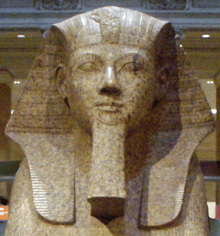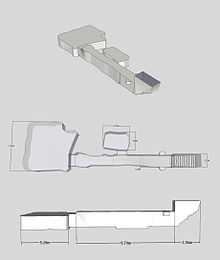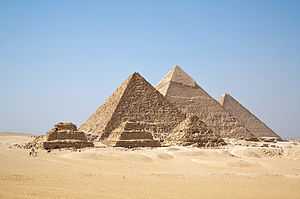KV60
| KV60 | |||
|---|---|---|---|
| Burial site of Sitre In and Hatshepsut | |||
 KV60 | |||
| Coordinates | 25°44′20.6″N 32°36′11.3″E / 25.739056°N 32.603139°ECoordinates: 25°44′20.6″N 32°36′11.3″E / 25.739056°N 32.603139°E | ||
| Location | East Valley of the Kings | ||
| Discovered | 1903 | ||
| Excavated by |
Howard Carter Edward R. Ayrton Donald P. Ryan | ||
|
| |||
Tomb KV60 in Egypt's Valley of the Kings is one of the more perplexing tombs of the Theban Necropolis, due to the uncertainty over the identity of one female mummy found there (KV60A), thought by some, such as the noted Egyptologist Elizabeth Thomas, to be that of 18th dynasty Pharaoh Hatshepsut.[1] This identification has recently been advocated by Egyptologist Zahi Hawass.[2]
History

When the tomb was discovered by Howard Carter in 1903, it was found to have been ransacked and desecrated in antiquity, but still held two mummies, along with some badly damaged grave goods; Carter apparently did little work in the tomb.
In 1906 Edward R. Ayrton reopened it, and removed one mummy, KV60B, together with the coffin it was in, to the Egyptian Museum. The coffin was inscribed with the name and title royal nurse, In. This personage has been widely identified with Sit-Ra, called In, who was the royal nurse of Hatshepsut. Since neither Carter nor Ayrton drew plans or maps indicating the location of the tomb, the whereabouts of the tomb became forgotten.
Thomas later (in 1966) speculated that the second (unidentified) mummy was that of Hatshepsut, relocated there (to the tomb of her nurse) by Thutmose III, as part of his campaign of official hostility towards her.
In 1990 the tomb was rediscovered, reopened and properly excavated by a team led by Donald P. Ryan and Mark Papworth. This produced evidence both in favour of, and casting doubt on, Thomas' theory. On the supporting side, the mummy proved to be that of a relatively elderly lady, with her left arm flexed in the pose thought to mark a royal mummy. On the other hand, none of the pottery fragments recovered during the excavation could be dated to the 18th Dynasty. Most interestingly, a wooden face-piece from a coffin possibly destined for a male (it seemingly had a place to fit a false beard) was found – but the tomb contained only females, and Hatshepsut is known to have used the false beard. The mummy was placed in a new wooden coffin, and left in the tomb, which was resealed.

In early 2007, the tomb was reopened and the second mummy, KV60A, removed for testing. On 27 June 2007, Supreme Council of Antiquities director Zahi Hawass offered what he considered to be definitive proof that this "corpulent, elderly" body was indeed Hatshepsut.[2] The mummy was found by CT scan to have one root of a missing molar. An unopened canopic box bearing the royal name of Hapshetsut was found by CT scan to contain a molar with one root missing. The size and shape of the root remaining in the mummy is claimed to fit the molar in the canopic box.
Doubts have been cast on this attribution, by, for example, Egyptology writer Dylan Bickerstaffe. He wrote about the molar, soon after the attribution was made, that "it is important that the join with the root in the mouth of the mummy is physically corroborated. DNA tests should then also be able to confirm that the
tooth and KV60A are one and the same person."[3] Later, in a 2013 book, science journalist Jo Marchant reported:
Most Egyptologists I’ve spoken to are very skeptical that this mummy has anything to do with Hatshepsut, and say they would like to study the team’s evidence. Unfortunately, neither the CT scans nor the DNA results have yet been published in a scientific journal. (Gad and Corthals [the DNA researchers] are quite open about the fact that their DNA results are far too preliminary to publish, and although Selim [who did the CT scan] describes the CT identification of Hatshepsut as "one of our greatest discoveries," he acknowledges that it has yet to be confirmed by DNA analysis.)[4]
References
Notes
- ↑ Highfield, Roger (27 June 2007). "How I found Queen Hatshepsut". Daily Telegraph (London). Retrieved 2014-09-22.
- ↑ 2.0 2.1 "Search for Hatshepsut".
- ↑ Bickerstaffe, D., The Burial of Hatshepsut. The Heritage of Egypt, Issue 1 - January 2008, pp. 2-9.
- ↑ Marchant, J., (2013), The Shadow King: The Bizarre Afterlife of King Tut's Mummy, Da Capo Press, 2013, Chapter 13.
Further reading
- Nicholas Reeves and Richard H. Wilkinson, The Complete Valley of the Kings (Thames & Hudson, 1996) pp. 186–187.
- Donald P. Ryan, "Who is buried in KV60", KMT 1:1, 1990.
- Siliotti, A. Guide to the Valley of the Kings and to the Theban Necropolises and Temples, 1996, A.A. Gaddis, Cairo.
External links
- Theban Mapping Project: KV60 – Plans of the tomb and other details.
- Donald Ryan's site – Contains photos of the mummy he found in KV60.
- Unidentified Mummies – More pictures and information on the mummies.
| ||||||||||||||||||||||
| ||||||||||||||||||||
